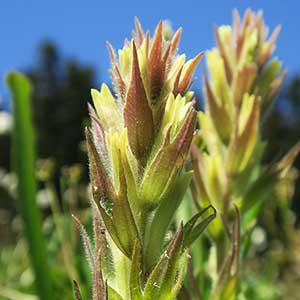Castilleja cryptantha
Castilleja peckiana
Mt. Rainier or obscure paintbrush, obscure Indian paintbrush, obscure paintbrush
peak paintbrush, Peck's Indian paintbrush, Peck's paintbrush
few to several, erect or ascending, unbranched, hairs spreading, long, soft, eglandular, mixed with short stipitate-glandular ones.
few to many, erect or ascending, often branched distally, sometimes unbranched, sometimes with short axillary shoots, proximal hairs retrorse to appressed, short to moderately long, distal hairs spreading, longer, soft, often mixed with short stipitate-glandular ones.
green, often with brown or purple veins, narrowly to broadly lanceolate, 1.5–4 cm, not fleshy, margins plane, ± involute, 0–3-lobed, apex acute to acuminate;
lobes spreading-ascending, narrowly lanceolate, apex acute to ± obtuse.
green, linear-lanceolate, rarely broadly lanceolate, (1.2–)2.5–8(–9) cm, not fleshy, margins plane, flat or involute, 0(–3)-lobed, apex acute to rounded;
lobes ascending-spreading, narrowly lanceolate to linear, apex acute or obtuse.
(2.5–)3–6 × 1–2 cm; green to dull brown or dull reddish purple throughout, or proximally green to dull brown or dull reddish purple, distally yellow on apices, broadly lanceolate to ovate, (0–)3-lobed;
lobes ascending, narrowly lanceolate, long or short, arising near mid length, apex acute or acuminate.
(2–)4–17 × 1.5–3 cm;
bracts proximally greenish, distally red, orange-red, or orange, proximal sometimes lanceolate, distal broadly lanceolate to ovate, (0–)3(–7)-lobed;
lobes spreading to ascending, linear to lanceolate, long, arising near or below mid length, central lobe apex rounded, lateral ones acute.
straight, 14–16 mm;
tube 11–14 mm;
whole corolla included within calyx;
beak adaxially pale yellow, 1–2 mm;
abaxial lip deep green, slightly inflated, 4–5 mm, 67% as long as beak;
teeth ascending, pale, 1.5–2 mm.
straight, 23–30(–35) mm;
tube 12–20 mm;
beak exserted, adaxially green, 8–12(–14) mm;
abaxial lip pale to deep green, reduced, rounded, 0.5–1.5 mm, 10–20% as long as beak;
teeth erect to incurved, green, (0.4–)0.7–1.2(–2) mm.
proximally green or pale with green veins, lobes yellow, sometimes becoming deep red with age, 12–15 mm;
abaxial and adaxial clefts 3–7 mm, 25–50% of calyx length, deeper than laterals, lateral 1–3(–4) mm, 8–20% of calyx length;
lobes triangular, adaxial segments longer than abaxials, apex acute or obtuse.
proximally pale yellow or greenish, distally colored as bracts, (15–)18–28 mm;
abaxial and adaxial clefts 6–12 mm, 40–45% of calyx length, deeper than laterals, lateral 2.5–8 mm, 20–30% of calyx length;
lobes linear to narrowly lanceolate, apex acute to acuminate.
= 24.
= 72, 96, ca. 120.
Castilleja cryptantha
Castilleja peckiana
Castilleja cryptantha is endemic to the vicinity of Mt. Rainier in the Cascade Range, with most populations found within Mt. Rainier National Park. Unlike most species of Castilleja, it is apparently self-pollinating (W. J. Duffield 1972); the small flowers are entirely enclosed within the yellowish calyces, which tend to grow deep reddish as they age. The purplish brown bracts are also unusual in the genus.
(Discussion copyrighted by Flora of North America; reprinted with permission.)
When describing Castilleja peckiana, Pennell noted that its variation approached C. hispida on one hand and C. miniata on the other, and it is likely of allopolyploid derivation. L. R. Heckard (1968) found chromosome numbers of n = 36, 48, and ca. 60. He hypothesized that C. chromosa, C. hispida var. acuta, and C. miniata were likely involved in its ancestry, and possibly C. pruinosa as well. Heckard suggested subsequent introgression among the derived forms introduced further complexity. Though complex, these forms are self-perpetuating and appear morphologically stable within their range.
(Discussion copyrighted by Flora of North America; reprinted with permission.)


